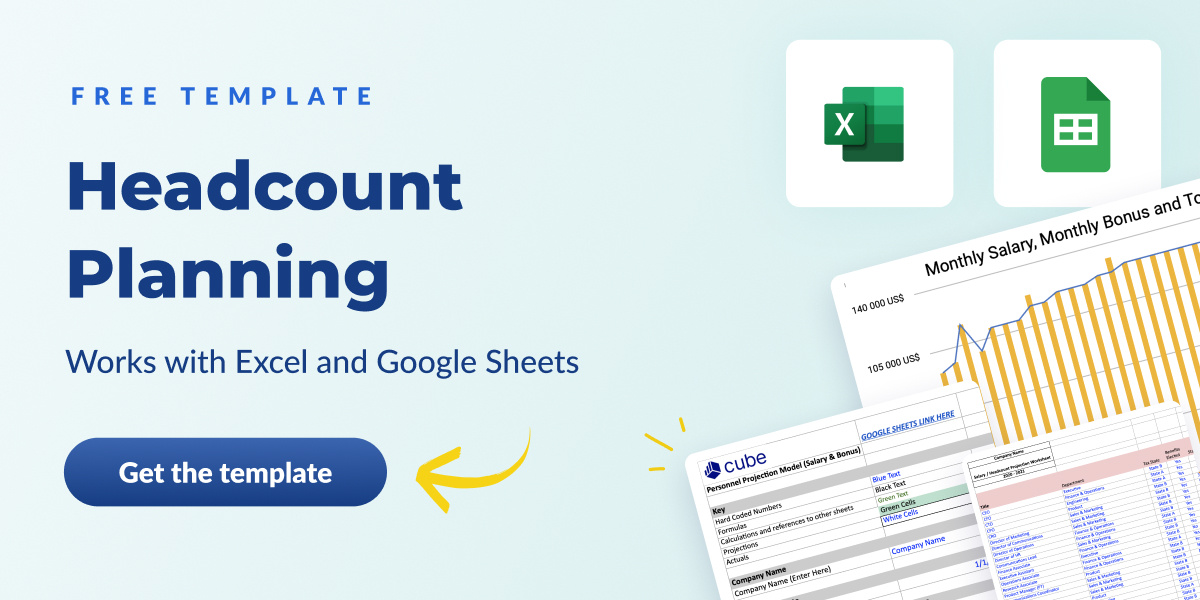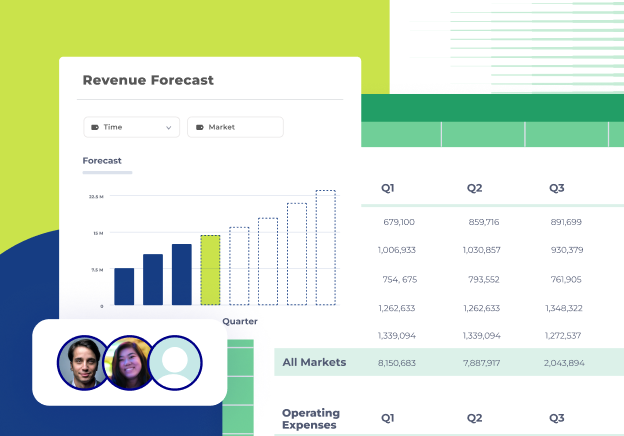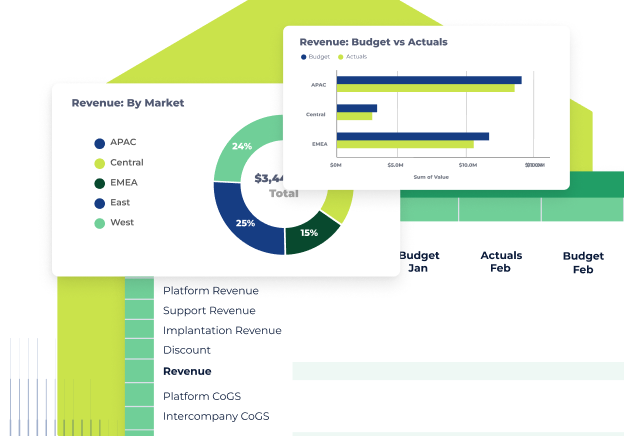Key takeaways on headcount forecasting
- Headcount forecasting is used to predict future staffing needs based on upcoming company goals and projects.
- It protects your company against over-staffing, which can cause project management issues, increased turnover, and new hires without a clear role, among other problems.
- Types of headcount forecasting include as-is analysis, recruitment sales forecasting, and succession planning.
- Learning proper headcount forecasting (and using a headcount planning template) can help you avoid common challenges, like inaccurate forecast results and poor outcome measurement.
What is headcount forecasting?
Headcount forecasting is a strategy for modeling a future headcount plan based on your current workforce. Creating a successful headcount plan (maybe with the help of workforce planning software) means creating multiple scenarios based on historical data.
Forecasting hiring for new employees ensures that future goals and your future capacity align. It also reveals skill gaps or obstacles managers may encounter when planning the roadmap and building teams around those plans.
Headcount forecasting vs headcount analysis vs workforce planning
Headcount forecasting, headcount analysis, and workforce planning each serve different purposes but work together to create a cohesive staffing strategy. Here’s how they compare:
- Headcount forecasting is forward-looking. It’s used to predict future staffing needs based on factors like growth goals, turnover, or upcoming projects. By anticipating what’s ahead, you can prepare your teams to meet company objectives without scrambling.
- Headcount analysis focuses on the present. It evaluates your current workforce to uncover strengths, gaps, or inefficiencies. Think of it as a snapshot that helps you spot misalignments, like areas where you might need to scale back or hire more talent.
- Workforce planning ties it all together. It’s the overarching strategy that aligns your staffing needs—both current and future—with your business goals. Workforce planning considers how to acquire, develop, and retain the talent you’ll need so you’re prepared to execute your strategy effectively.
Each of these processes complements the others, giving you a full view of your workforce, both now and in the future. Together, they help ensure you’ve got the right people in the right roles at the right time.
What's the cost of poor headcount planning?
Headcount planning protects against creating too-large staffing levels that are detrimental to business operations. These can lead to project management issues, increased turnover, new hires without a clear role, and unhappy business owner(s).
You can also end up in a situation where human resources (or people operations) is behind on budget or is overwhelmed with candidates because you didn't plan—so the best way to ensure critical roles are filled on time is to make a plan.

Type of headcount forecasting
The workforce planning you perform depends on the data you want to understand. There are a few common forms of headcount forecasting and analysis that reveal different data points about your organization and hiring needs. They include:
As-is analysis
An as-is analysis evaluates the current state of your workforce. It involves consolidating your current headcount data into a single database so you can assess it against factors like organizational structure, roles, work grades, demographics, and other data. This results in a better understanding of the gaps and opportunities in your workforce.
Headcount demand forecasting
Estimating the type and number of employees your company will need is headcount demand forecasting. The estimate is based on factors like business goals and development roadmaps. It helps align staffing levels with future business needs, informing HR’s decisions and cadence.
Headcount supply forecasting
Headcount supply forecasting involves estimating the availability (internal or external) of talent over a specific future period. Doing so can help you understand the required talent and effort to meet project roadmap requirements. It’s also a crucial step toward anticipating potential gaps in skills or resources.
Recruitment sales forecasting
Recruitment sales forecasting estimates the number of hires you intend to make over the next period (month, quarter, half year, or year). The forecast outlines the costs of these hires and estimates the associated revenue they will generate. This type of planning accompanies internal sales forecast exercises, such as sales quota capacity planning.
Succession planning
Planning for the expected staff flow into and out of your organization is known as succession planning. With a succession plan, you identify the critical positions within the company that must remain filled. Then you form an action plan for filling those roles as current employees cycle out due to promotion, separation, or retirement.
How to do headcount forecasting
Headcount forecasting is all about being prepared for the future by aligning your workforce strategy with your company’s goals. Here’s how to do headcount forecasting—and do it well.
1. Identify your organization’s workforce goals
The first step in proper headcount forecasting is understanding what your company is trying to achieve. Meet with stakeholders, department heads, and managers to get a clear picture of the organization’s short-term and long-term objectives. Ask questions about current challenges, upcoming projects, and areas where teams feel under-resourced or overstaffed.
Getting input from various leaders ensures your headcount forecast aligns with your company’s strategic planning and priorities. It can also help uncover pain points or opportunities that might not be immediately obvious.
2. Define KPI and metrics for measuring success
KPIs and metrics are your benchmarks for knowing whether your headcount forecast—along with any related financial forecasting—is on track. They provide measurable points of reference that guide your decision-making and allow you to course-correct when necessary.
Some important KPIs and metrics to focus on include:
- Headcount variance: Tracks how closely your actual headcount matches your forecast.
- Retention rate: Measures employee stability over a given time period.
- Time-to-fill: Calculates how long it takes to hire for open positions.
- Cost per hire: Tracks the total expenses associated with hiring a single employee.
- Revenue per employee: Evaluates workforce efficiency by linking headcount to revenue generation.
By defining these KPIs and metrics upfront, you’ll have tangible ways to measure success and adjust your forecast based on real results.
3. Assess your current workforce
Before you can plan for the future, you need to know where your workforce stands today. That means completing a comprehensive audit that includes roles, skills, performance, and demographics, followed by a gap analysis to identify areas where your workforce isn’t meeting current or future needs.
For example, are there critical skills missing in key departments? Or are there inefficiencies in how resources are allocated? You might discover that your engineering team lacks expertise in emerging technologies crucial for upcoming projects, or that your sales team is understaffed for projected growth. Pinpointing these gaps lays the foundation for informed planning and prioritization.
4. Determine your current headcount and burn costs
To calculate your current headcount, take the number of active team members you have, add upcoming hires, and subtract pending terminations.
Headcount = Current active employees + upcoming hires - pending terminations
For example, if you have 250 current staffers, are hiring another 100, with 25 soon-to-be let go, your current headcount would be 325. (250 + 100 - 25 = 325).
Next, determine your burn costs to understand how much you’re spending on salaries, benefits, and other workforce-related expenses using the following formula:
Burn rate = Revenue - operating expenses
Knowing these numbers gives you a clear financial picture and helps you identify where you can optimize. That way, your headcount forecast is grounded in reality, not guesswork.
5. Create and implement your forecast
Once you’ve collected your data, it’s time to put it into action. Use a headcount planning template to create a detailed timeline that outlines hiring priorities, budget allocations, and key milestones. Focus first on filling urgent skill gaps, then shift to longer-term growth positions. Develop cost projections for different scenarios, considering both direct costs (like salaries and benefits) and indirect costs (training or equipment). Also consider market salary trends, inflation, and regional cost variations.
Share your forecast clearly with teams (like HR and sales), stakeholders, and leadership. Explain how the plan connects to organizational goals and what each group’s role is in its execution. Establish regular check-ins to address challenges and make necessary adjustments and keep detailed documentation of decisions—and their rationale.
6. Monitor and revise your forecast
Regular monitoring keeps your plan relevant as conditions change. Track your progress against the KPIs and metrics you established earlier. Conduct monthly or quarterly reviews to assess what’s working and what isn’t. For example, if hiring timelines are slipping, dig into the reasons why and define how you’ll adjust your approach.
Benefits of proper headcount forecasting
Successfully planning your headcount and future needs offers a range of financial and strategic planning benefits. From better project planning and workforce balancing to more accurate budgets and capital efficiency, taking a detailed and thoughtful approach can greatly reduce uncertainty and improve outcomes:
1. Improved employee satisfaction
Balancing human capital with business demands ensures employees experience a healthy workload and remain engaged without burning out.
Keeping an optimal total headcount through accurate forecasting can extend the tenure of your current employees and reduce costly turnover and loss of your institutional knowledge base.
Happier employees mean you'll score better on those common workforce metrics: employee NPS, attrition, and overall performance. It's a good idea to establish metrics like this when you create your headcount model.
2. More accurate financial planning
Forecasting employee wages can be tricky. By building comprehensive headcount modeling, you can better understand the salary and compensation increases necessary to achieve business goals. This results in more accurate departmental budgets and less friction in project management and on HR teams. It also means it's easier to onboard new hires.
3. Faster time to market
Making the most of your workforce and strategically adding headcount improves the ability to deliver roadmap objectives on time. That creates a positive impact on the entire business. Workforce planning also ensures you have the right roles working on business activities.
4. More workforce visibility
Headcount planning and forecasting go beyond simple wage estimates to deliver visibility into your evolving org chart. This kind of real-time data is invaluable to most companies. Comprehensive modeling reveals skill gaps that may delay the timely delivery of objectives. In many organizations, business leaders and internal stakeholders who manage teams will appreciate the transparency.
5. Better capital efficiency
By fine-tuning your hiring cadence, organizations optimize one of their biggest cost centers. This improves capital efficiency, resulting in higher profit margins. This might also result in lower customer success turnover or less logo churn because you have the key people in the right places as the business grows.

What challenges do businesses face in headcount forecasting?
Headcount forecasting is both a creative and a quantitative process. While looking at the hard costs of employee acquisition and retention is valuable, a more holistic view often has better results. Finance and HR face several common challenges when forecasting and workforce planning:
Inaccurate forecast results
Forecasting is an art and a science. When forecasting future needs, ensure you have the most accurate data available. Get clear directives from department heads about upcoming needs and project alignment. Where necessary, use sensitivity analysis to understand the effects of changing variables on the financial model.
Changing priorities
Roadmaps change as new business intelligence emerges. This understandably impacts human capital needs and costs. Opt for a continuous cycle of evaluation and adjustment to ensure your headcount forecast remains aligned with organizational needs over the fiscal year.
Lack of “big picture” thinking
Hiring a new staff member results in various costs beyond salary. When forecasting human capital costs, be sure to account for the ancillary costs associated with new hires:
- Recruiting costs
- Training
- Equipment
- Compensation package
- Remote office stipends
- Real estate costs (for in-house workers)
- Travel (for interviews or work activities)
By including the full cost of a new hire, you ease the burden on finance and end up with more accurate forecasting overall.
Poor outcome measurement
The success of your forecasting, hiring, and workforce management efforts depends on measuring the desired outcomes. It’s essential to keep staffing numbers optimized, but just as important to deliver the desired business objectives within proposed time frames. Establishing and tracking key performance indicators (KPIs) and other performance metrics can help show the ROI of your forecasting efforts.
Want a head start optimizing your headcount forecasting? Our Excel workforce planning template gives you all the structure to accurately and quickly forecast human capital needs.
How are P&L and headcount connected?
Human capital is one of the most expensive operating expenses on the budget. Perfecting the balance between hiring and spending leads to better business outcomes, faster market time, more efficient cash use, and lower employee churn. Specific ways proper headcount forecasting can positively impact the profit and loss statement include:
- Hiring engaged and aligned talent results in higher revenue outcomes. Talent drives value and results in better-quality products and higher client satisfaction.
- Productive employees, especially those involved in direct labor, reduce the cost of production by putting out consistent, quality products and services.
- Effective hiring reduces operating expenses such as hiring expenses, onboarding investment, new hire training, and ongoing employee enrichment programs.
- Higher engagement from satisfied employees lowers internal and external risks from sources such as legal action, penalties, fines, and other performance-associated costs.
Controlling hiring through effective forecasting and needs assessments equals having the right people engaged in the best activities. In the long run, this drives down costs and strengthens your company’s position.
Get started with a free headcount forecasting template
Now that you know all about headcount forecasting, it's time to download our free headcount forecasting template. The template is built to make your workforce planning as seamless as possible. It provides an organized framework for inputting historical data, projecting future headcount needs, and calculating costs with precision.
With clear instructions and pre-set formulas, our free headcount forecasting template simplifies the process of analyzing data and creating actionable forecasts. Whether you're planning for growth, filling skill gaps, or refining your hiring cadence, our template gives you the structure to plan effectively.
Just enter your email in the form, input your historical data into the spreadsheet, and voila—you're ready to start building a more strategic workforce plan. It’s an easy first step toward aligning your headcount forecasting with your business goals.
Download the free template



.png)









.png)

![What is headcount forecasting? [Free template]](https://www.cubesoftware.com/hubfs/Headcount%20Forecasting%20(1)-1.png)


![15 of the best workforce planning software tools [2026]](https://www.cubesoftware.com/hubfs/workforce%20planning-1.png)
%20(1).png)
.png)